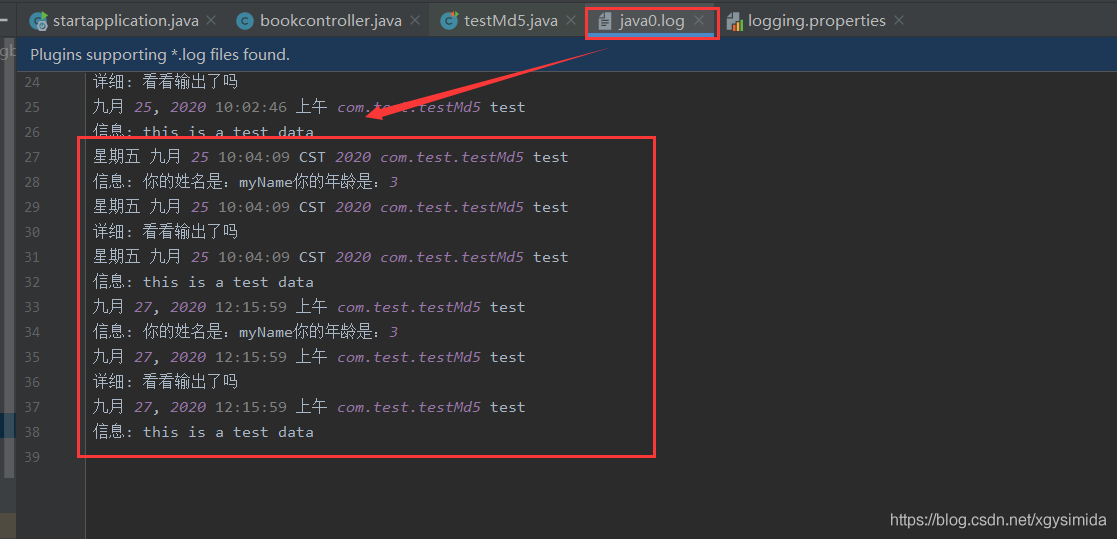Android使用RSA加密實現接口調用時的校驗功能
RSA算法是一種非對稱加密算法,那么何為非對稱加密算法呢?
一般我們理解上的加密是這樣子進行的:原文經過了一把鑰匙(密鑰)加密后變成了密文,然后將密文傳遞給接收方,接收方再用這把鑰匙(密鑰)解開密文。在這個過程中,其實加密和解密使用的是同一把鑰匙,這種加密方式稱為對稱加密。
而非對稱加密就是和對稱加密相對,加密用的鑰匙和解密所用的鑰匙,并不是同一把鑰匙。非對稱加密首先會創建兩把鑰匙,而這兩把鑰匙是成對的分別稱為公鑰和私鑰。在進行加密時我們使用公鑰進行加密,而在解密的時候就必須要使用私鑰才能進行解密,這就是非對稱加密算法。
假如使用非對稱加密,甲發送消息給乙,這時候乙會預先創建好兩把鑰匙,私鑰乙自己保存好,然后把公鑰發送給甲,甲使用公鑰對信息進行加密,然后傳給乙。最后乙使用自己的私鑰對數據進行解密。這個過程中,公鑰還是有可能被第三者所截獲,但是不同的是,這個第三者縱然得到了公鑰,也無法解開密文,因為解密密文所需要的私鑰從始至終一直在乙的手里。因此這個過程是安全的。
在一個Android應用中錄音完成后將錄音文件上傳到SpringBoot搭建的后臺接口中。
由于Android應用中沒有登錄功能,所以需要對一串自定義字符串進行加密并傳輸,然后在SpringBoot后臺進行解密驗證。防止上傳接口暴露。
實現首先在SpringBoot端新建一個RsaUtils工具類
import com.sun.org.apache.xerces.internal.impl.dv.util.Base64;import java.io.ByteArrayOutputStream;import java.security.KeyFactory;import java.security.KeyPair;import java.security.KeyPairGenerator;import java.security.PrivateKey;import java.security.PublicKey;import java.security.Signature;import java.security.spec.PKCS8EncodedKeySpec;import java.security.spec.X509EncodedKeySpec;import java.util.Base64;import javax.crypto.Cipher;//java 后端public class RsaUtils { //私鑰 public static String privateKey = '自己生成的私鑰'; //公鑰 private static String publicKey = '自己生成的公鑰'; /** * RSA最大加密明文大小 */ private static final int MAX_ENCRYPT_BLOCK = 117; /** * RSA最大解密密文大小 */ private static final int MAX_DECRYPT_BLOCK = 128; /** * 獲取密鑰對 * * @return 密鑰對 */ public static KeyPair getKeyPair() throws Exception { KeyPairGenerator generator = KeyPairGenerator.getInstance('RSA'); generator.initialize(1024); return generator.generateKeyPair(); } /** * 獲取私鑰 * * @param privateKey 私鑰字符串 * @return */ public static PrivateKey getPrivateKey(String privateKey) throws Exception { KeyFactory keyFactory = KeyFactory.getInstance('RSA'); byte[] decodedKey = com.sun.org.apache.xerces.internal.impl.dv.util.Base64.decode(new String(privateKey.getBytes())); PKCS8EncodedKeySpec keySpec = new PKCS8EncodedKeySpec(decodedKey); return keyFactory.generatePrivate(keySpec); } /** * 獲取公鑰 * * @param publicKey 公鑰字符串 * @return */ public static PublicKey getPublicKey(String publicKey) throws Exception { KeyFactory keyFactory = KeyFactory.getInstance('RSA'); byte[] decodedKey = Base64.decode(publicKey); X509EncodedKeySpec keySpec = new X509EncodedKeySpec(decodedKey); return keyFactory.generatePublic(keySpec); } /** * RSA加密 * * @param data 待加密數據 * @param publicKey 公鑰 * @return */ public static String encrypt(String data, PublicKey publicKey) throws Exception { Cipher cipher = Cipher.getInstance('RSA'); cipher.init(Cipher.ENCRYPT_MODE, publicKey); int inputLen = data.getBytes().length; ByteArrayOutputStream out = new ByteArrayOutputStream(); int offset = 0; byte[] cache; int i = 0; // 對數據分段加密 while (inputLen - offset > 0) { if (inputLen - offset > MAX_ENCRYPT_BLOCK) { cache = cipher.doFinal(data.getBytes(), offset, MAX_ENCRYPT_BLOCK); } else { cache = cipher.doFinal(data.getBytes(), offset, inputLen - offset); } out.write(cache, 0, cache.length); i++; offset = i * MAX_ENCRYPT_BLOCK; } byte[] encryptedData = out.toByteArray(); out.close(); // 獲取加密內容使用base64進行編碼,并以UTF-8為標準轉化成字符串 // 加密后的字符串 return new String(Base64.encode((encryptedData))); } /** * RSA解密 * * @param data 待解密數據 * @param privateKey 私鑰 * @return */ public static String decrypt(String data, PrivateKey privateKey) throws Exception { Cipher cipher = Cipher.getInstance('RSA'); cipher.init(Cipher.DECRYPT_MODE, privateKey); byte[] dataBytes = Base64.decode(data); int inputLen = dataBytes.length; ByteArrayOutputStream out = new ByteArrayOutputStream(); int offset = 0; byte[] cache; int i = 0; // 對數據分段解密 while (inputLen - offset > 0) { if (inputLen - offset > MAX_DECRYPT_BLOCK) { cache = cipher.doFinal(dataBytes, offset, MAX_DECRYPT_BLOCK); } else { cache = cipher.doFinal(dataBytes, offset, inputLen - offset); } out.write(cache, 0, cache.length); i++; offset = i * MAX_DECRYPT_BLOCK; } byte[] decryptedData = out.toByteArray(); out.close(); // 解密后的內容 return new String(decryptedData, 'UTF-8'); } /** * 簽名 * * @param data 待簽名數據 * @param privateKey 私鑰 * @return 簽名 */ public static String sign(String data, PrivateKey privateKey) throws Exception { byte[] keyBytes = privateKey.getEncoded(); PKCS8EncodedKeySpec keySpec = new PKCS8EncodedKeySpec(keyBytes); KeyFactory keyFactory = KeyFactory.getInstance('RSA'); PrivateKey key = keyFactory.generatePrivate(keySpec); Signature signature = Signature.getInstance('MD5withRSA'); signature.initSign(key); signature.update(data.getBytes()); return Base64.encode(signature.sign()); } /** * 驗簽 * * @param srcData 原始字符串 * @param publicKey 公鑰 * @param sign 簽名 * @return 是否驗簽通過 */ public static boolean verify(String srcData, PublicKey publicKey, String sign) throws Exception { byte[] keyBytes = publicKey.getEncoded(); X509EncodedKeySpec keySpec = new X509EncodedKeySpec(keyBytes); KeyFactory keyFactory = KeyFactory.getInstance('RSA'); PublicKey key = keyFactory.generatePublic(keySpec); Signature signature = Signature.getInstance('MD5withRSA'); signature.initVerify(key); signature.update(srcData.getBytes()); return signature.verify(Base64.decode(sign)); }/* public static void main(String[] args) { try { // 生成密鑰對 KeyPair keyPair = getKeyPair(); String privateKey = new String(Base64.getEncoder().encode(keyPair.getPrivate().getEncoded())); String publicKey = new String(Base64.getEncoder().encode(keyPair.getPublic().getEncoded())); System.out.println('私鑰:' + privateKey); System.out.println('公鑰:' + publicKey); // RSA加密*//* String data = '待加密的文字內容'; String encryptData = encrypt(data, getPublicKey(publicKey)); System.out.println('加密后內容:' + encryptData); // RSA解密 String decryptData = decrypt('encryptData ', getPrivateKey(privateKey)); System.out.println('解密后內容:' + decryptData); // RSA簽名 String sign = sign(data, getPrivateKey(privateKey)); // RSA驗簽 boolean result = verify(data, getPublicKey(publicKey), sign); System.out.print('驗簽結果:' + result);*//* } catch (Exception e) { e.printStackTrace(); System.out.print('加解密異常'); } }*/}
然后運行此工具類的main方法中的生成密鑰對的方法,獲取到生成的公鑰和密鑰對。

然后將它們賦值到最上面的privateKey和publicKey。
然后在Android端中也新建一個工具類RsaUtils
package com.badao.badaoimclient.common;import android.util.Base64;import java.io.ByteArrayOutputStream;import java.security.KeyFactory;import java.security.PublicKey;import java.security.spec.X509EncodedKeySpec;import javax.crypto.Cipher;public class RsaUtils{ //公鑰 public static String publicKey='跟Java端同樣的公鑰'; /** * RSA最大加密明文大小 */ private static final int MAX_ENCRYPT_BLOCK = 117; /** * RSA最大解密密文大小 */ private static final int MAX_DECRYPT_BLOCK = 128; /** * 獲取公鑰 * * @param publicKey 公鑰字符串 * @return */ public static PublicKey getPublicKey(String publicKey) throws Exception { KeyFactory keyFactory = KeyFactory.getInstance('RSA'); byte[] decodedKey =Base64.decode(publicKey.getBytes(), Base64.DEFAULT); X509EncodedKeySpec keySpec = new X509EncodedKeySpec(decodedKey); return keyFactory.generatePublic(keySpec); } /** * RSA加密 * * @param data 待加密數據 * @param publicKey 公鑰 * @return */ public static String encrypt(String data, PublicKey publicKey) throws Exception { Cipher cipher ; cipher= Cipher.getInstance('RSA/ECB/PKCS1Padding'); cipher.init(Cipher.ENCRYPT_MODE, publicKey); int inputLen = data.getBytes().length; ByteArrayOutputStream out = new ByteArrayOutputStream(); int offset = 0; byte[] cache; int i = 0; // 對數據分段加密 while (inputLen - offset > 0) { if (inputLen - offset > MAX_ENCRYPT_BLOCK) { cache = cipher.doFinal(data.getBytes(), offset, MAX_ENCRYPT_BLOCK); } else { cache = cipher.doFinal(data.getBytes(), offset, inputLen - offset); } out.write(cache, 0, cache.length); i++; offset = i * MAX_ENCRYPT_BLOCK; } byte[] encryptedData = out.toByteArray(); out.close(); // 獲取加密內容使用base64進行編碼,并以UTF-8為標準轉化成字符串 // 加密后的字符串 return new String(Base64.encode(encryptedData, Base64.DEFAULT)); }}
這里的公鑰與上面生成的公鑰一致。
注意著兩個工具類的區別
在Android工具類中的Base64引入的是
import android.util.Base64;
而在Java中引入的Base64是
import com.sun.org.apache.xerces.internal.impl.dv.util.Base64;
注意這里為什么不是引用java.util.Base64,因為會有換行導致的轉移字符的問題。
然后在Android中對字符串進行加密
//獲取加密字符串String escode = '';try { escode = RsaUtils.encrypt(key,RsaUtils.getPublicKey(RsaUtils.publicKey)); } catch (Exception e) { e.printStackTrace();}
將其作為接口調用的參數傳遞到Java中進行解密
if(decode.equals(RsaUtils.decrypt(key,RsaUtils.getPrivateKey(RsaUtils.privateKey)))) { try { // 上傳文件路徑 String filePath = RuoYiConfig.getUploadPath(); // 上傳并返回新文件名稱 String fileName = FileUploadUtils.upload(filePath, file); String url = serverConfig.getUrl() + fileName; AjaxResult ajax = AjaxResult.success(); ajax.put('fileName', fileName); ajax.put('url', url); return ajax; } catch (Exception e) { return AjaxResult.error(e.getMessage()); } }else { return AjaxResult.error('非法訪問'); }
這樣就限制了只能通過指定的移動端對文件上傳接口進行訪問。
在移動端調用接口進行測試

可見調用接口前加密成功
并且能用過后臺接口的解密校驗

這樣別的第三方請求接口就沒法請求

以上就是Android使用RSA加密實現接口調用時的校驗功能的詳細內容,更多關于Android rsa加密接口調用的資料請關注好吧啦網其它相關文章!
相關文章:

 網公網安備
網公網安備